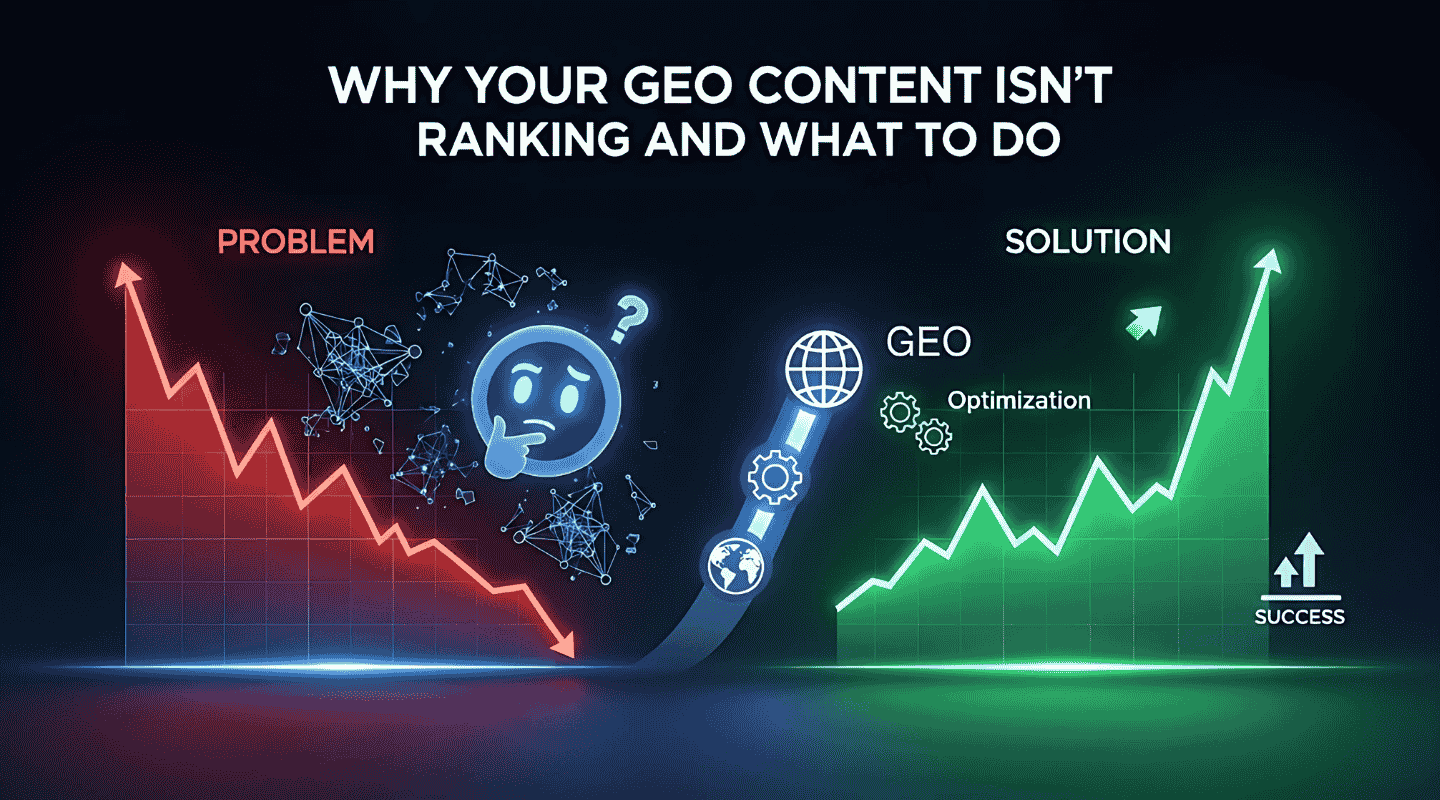Introduction
You’ve put time, effort, and budget into creating GEO-targeted content—only to find it’s buried on page two, three, or worse. If your content isn’t showing up in local or regional searches, you’re not alone. In fact, research shows that 75% of searchers never scroll past the first page of Google. That means if your GEO content isn’t ranking, you’re missing out on customers, conversions, and credibility.
So, why is your GEO content invisible? More importantly, what can you do to fix it—fast? This blog dives deep into the top reasons your GEO content isn’t ranking and provides actionable strategies to boost visibility, engagement, and results.
1. You’re Targeting the Wrong Keywords
One of the biggest culprits behind poor GEO rankings is keyword mismatch. Many businesses focus on broad, generic keywords like “best digital marketing” when they should be targeting location-specific keywords like “best digital marketing agency in Dallas”.
Solution:
- Use tools like Google Keyword Planner, SEMrush, or Ahrefs to find geo-modified keywords.
- Focus on long-tail, intent-driven queries such as “affordable home renovation contractor in Houston”.
- Place your primary GEO keyword naturally in your title, headers, meta description, and content body.
2. Your NAP Data Is Inconsistent
NAP (Name, Address, Phone number) consistency is a local SEO essential. If your business listings vary across platforms (Google Business Profile, Yelp, social media, directories), search engines struggle to trust your location.
Solution:
- Ensure your NAP is identical across all channels.
- Claim and optimize your Google Business Profile (GBP).
- Use tools like BrightLocal or Moz Local to track inconsistencies.
3. You’re Ignoring Localized On-Page SEO
Even great content fails if on-page SEO doesn’t align with GEO intent. Search engines want to see structured signals that reinforce your local relevance.
Solution:
- Add city/state names in H1, H2, and meta tags.
- Embed a Google Map on your contact or location page.
- Use schema markup (LocalBusiness, Organization) to help search engines interpret your business data.
4. Thin or Generic Content
Google favors unique, valuable, and locally-relevant content. If your content is thin (under 500 words), duplicated, or overly generic, it won’t rank.
Solution:
- Create in-depth, long-form blogs (1000+ words) that include local insights.
- Write case studies, testimonials, or location-based success stories.
- Incorporate statistics, trends, and cultural elements relevant to your GEO audience.
5. Weak Backlink Profile
Backlinks remain a top ranking factor. If your competitors earn links from local directories, blogs, or news sites and you don’t, they’ll outrank you.
Solution:
- Build backlinks from local chambers of commerce, newspapers, and event sites.
- Partner with influencers or micro-bloggers in your region.
- Submit press releases about community events or business updates.
6. Mobile Optimization Issues
Nearly 60% of all searches happen on mobile, and local intent is even stronger on mobile devices. If your GEO content isn’t optimized for small screens, expect poor rankings.
Solution:
- Use responsive web design to ensure mobile-friendliness.
- Test your site on Google’s Mobile-Friendly Test tool.
- Optimize page speed using tools like GTmetrix or PageSpeed Insights.
7. Poor User Experience (UX)
Search engines reward websites that keep users engaged. If your GEO content has high bounce rates or low dwell time, rankings suffer.
Solution:
- Use clear CTAs (Call-to-Action) for local intent (e.g., “Book a Free Consultation in Miami Today”).
- Structure your content with short paragraphs, bullet points, and visuals.
- Improve internal linking to guide users toward conversions.
8. You’re Not Leveraging Reviews and Social Proof
Online reviews influence 88% of local search decisions. A lack of reviews—or worse, poor ones—weakens your credibility.
Solution:
- Encourage happy customers to leave reviews on Google, Yelp, and Facebook.
- Showcase testimonials and star ratings on your website.
- Respond to every review, positive or negative, to build trust.
FAQs About GEO Content Rankings
Q1: How long does it take for GEO content to rank?
It depends. On average, it takes 3–6 months for local content to gain traction, but results can come faster with strong optimization.
Q2: Do I need different pages for each location?
Yes. If you serve multiple regions, create dedicated landing pages with unique content for each area. Avoid duplicating the same content across multiple pages.
Q3: Can social media improve GEO rankings?
Indirectly, yes. Social signals like shares, engagement, and local check-ins drive traffic and build brand authority, which supports your SEO.
Q4: Should I invest in paid ads while waiting for GEO rankings?
Absolutely. Paid ads like Google Ads or Local Services Ads can bridge the gap while your organic rankings build.
Q5: How important is schema markup for GEO content?
Very important. Schema markup helps search engines understand your business details, boosting chances of appearing in rich snippets and local packs.
Conclusion
If your GEO content isn’t ranking, don’t panic—it’s fixable. From keyword targeting and NAP consistency to backlinks and reviews, every small step improves your visibility. By implementing the strategies above, you’ll not only climb search rankings but also attract high-intent, local customers who are ready to buy.
In today’s competitive landscape, GEO SEO isn’t optional—it’s essential. Start optimizing today, and watch your content move from invisible to impossible-to-ignore.





